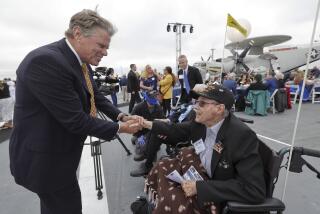Richard Best, 91; Pilot Helped to Sink 2 Japanese Carriers in Battle of Midway
- Share via
Richard H. Best, a former Navy bomber pilot who scored hits on two of the four Japanese aircraft carriers sunk in the critical Battle of Midway during World War II, has died. He was 91.
Best, a retired security manager at the Rand Corp., died Oct. 26 in Santa Monica.
The Battle of Midway--June 4-6, 1942--is considered the decisive battle of the war in the Pacific.
Before the battle, according to experts at the Naval Historical Center in Washington, the Japanese were on the offensive and had planned to capture Midway to use it as an advance base and entrap and destroy the U.S. Pacific Fleet.
But the Pacific Fleet surprised the Japanese forces and sank its four carriers, which had attacked Pearl Harbor only six months earlier. After the victory at Midway, the Allies took the offensive in the Pacific.
For his actions in the battle, Best received the Navy Cross and the Distinguished Flying Cross.
“He exemplified the young Navy pilots who turned the tide of the second world war,” said Jack Green of the Naval Historical Center.
“He never bragged about it, but he was obviously very proud of it because he would tell of his experiences to groups such as ours,” said Matthew H. Portz, a retired Navy captain who, along with Best, belonged to the Order of Daedalians, the national fraternity of military pilots.
Born in Bayonne, N.J., Best was inspired to become a pilot by listening to the exploits of air veterans of World War I. He graduated from the U.S. Naval Academy in 1932, served on the light cruiser Richmond and began flight training in 1934. He later taught instrument flying and evaluated torpedo bomber tactics in Pensacola, Fla.
In June 1940, Best returned to the fleet and requested to be assigned to dive bombers.
“I knew that I could make the most contribution as a bomber rather than a fighter,” he told The Hook, a journal of carrier aviation, in 1996.
By mid-1942, Best was an experienced combat pilot assigned to the aircraft carrier Enterprise in the Pacific.
Portz, who interviewed Best recently for an upcoming article in the Order of Daedalians’ quarterly magazine, said that the Americans had broken the Japanese code and learned that the enemy fleet was on its way to Midway.
On the morning of June 4, 1942, the Enterprise and two other American carriers--the Yorktown and the Hornet--were a few hundred miles from Midway Island when a patrol plane spotted Japanese aircraft carriers and their escorts heading toward the island.
That morning, Portz said, torpedo bombers from the three American carriers attacked three of the Japanese carriers and were almost wiped out by Japanese fighter planes and anti-aircraft fire.
But the attacking American torpedo bombers drew down the enemy fighters close to the water, Portz said, and while the Japanese fighters were attacking the torpedo bombers, the American dive bombers were able to hit the Japanese carriers.
Bombers from the Enterprise hit the Akagi and the Kaga. Dive bombers from the Yorktown hit the Soryu.
Of the 15 planes in Best’s squadron, Portz said, only three returned to the Enterprise in good condition. A fourth plane came in later but was badly shot up.
That afternoon, Best and his remaining squadron members and another Enterprise bomber squadron went after the Hiryu, the one Japanese carrier that had escaped being hit in the morning.
Best and his squadron succeeded in destroying it, but unlike the morning mission when the Japanese fighters were down low defending against the American torpedo bombers, they were aloft.
“Hiryu threw everything she had at us,” Best told Portz. “I never tried to look where my bomb hit: she was shooting, the battleships were shooting, and the Zeros were swarming around. I dropped all the way to the deck to get out of there.”
Although Best returned unharmed after a day’s work in hitting the Akagi and the Hiryu, the Battle of Midway turned out to be his last.
After returning to the Enterprise, he began coughing up blood and developed a fever. He was transferred to the hospital in Pearl Harbor, where X-rays showed cloudy spots on his lungs.
While flying the first mission during the Battle of Midway, a faulty oxygen canister had created gases that turned to caustic soda. He had breathed in the soda to clear it out. And the caustic soda, he was told, had activated latent tuberculosis.
“I knew my career was dead,” Best told Portz. “I never flew again.”
After undergoing 32 months of treatment, Best retired from the Navy in 1944 with a 100% disability. Between ages 32 and 42, Portz said, Best spent four years in and out in the hospital recovering from tuberculosis.
After the war, he worked at Douglas Aircraft and in 1947 he joined the Rand Corp.
He is survived by his daughter, Barbara Ann Llewellyn; his son, Richard Halsey Best II; and a grandson.
Interment will be at Arlington National Cemetery.
More to Read
Sign up for Essential California
The most important California stories and recommendations in your inbox every morning.
You may occasionally receive promotional content from the Los Angeles Times.













